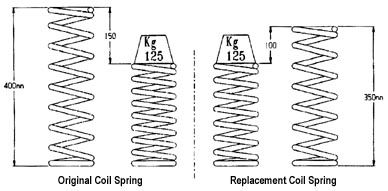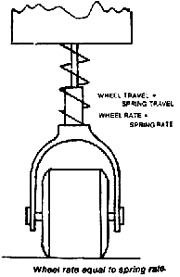http://www.preludepower.com/forums/show ... p?t=263138YellaLude wrote:Ok guys, ive noticed there is alot of debate about what coilovers/suspension to get for our Preludes, and in particular confusion over Spring Rates, so i thought it would be a good idea to create an Official Spring Rate Comparsion Chart that everyone can contribute to and use for future reference, instead of creating new topics all the time which only covers the same points and opinions time and time again.
Everyone has their own opinions on the 'ideal' spring rate for use on a 5th Gen Prelude, but this chart will hopefully help people choose what is the best setup for them personally.
If you know the spring rate of your setup and have a link to prove it is what you say it is. Then please post up the Brand, Spring Rates in Kg (Front & Back) and the Link/URL to where you found this information. I will then add your contribution to the OP.
As you can see, i have already made a start to the list and also added some brands that need information putting to them. If you have a brand not listed, please still feel free to contribute and i or a moderater will add it to the list.
We all know that the higher the spring rate, the stiffer they are, and the lower the spring rate, the softer they are. BUT this can also be affected by wether it is a Helper or Non Helper spring and these characteristics can be altered somewhat with a dampner control system.
Some manufacturers also offer a choice of Spring Rates, so with your help, this thread can provide everything anyone needs to know when it comes to choosing the right spring rate and coilover for them.
What is "Spring Rate" and why should I know about it?
A spring will be compressed when a load is applied. The distance it is compressed (deflected) for that given load is referred to as the spring rate. Spring rate is specified in terms of force applied per distance of deflection. Typically, the units of spring rate are pounds force per Inch or using the metric Sl system - Newton's per millimeter. We can just as easily convert the pounds into kilograms and measure the deflection in millimeters.
If a load of 1 kg deflects a spring 1-mm, each additional 1-kg will deflect it another mm. For each kg removed from the load the spring will return one mm toward its original state. The spring may be loaded at the rate of 1 kg per mm until it is deflected beyond its capacity. This means the spring will become damaged and will not resume its original characteristics when the load is removed. This point is called the elastic limit. A spring loaded beyond the elastic limit is deformed permanently.
In this example using linear design coils, both springs have 125 kg's of force applied to them. The standard spring has deflected 150mm from its original height. It therefore has a spring rate of 125 kg's per 150 mm, or 0.833 kg's/mm.
The replacement coil however with the same force only deflects 100 mm. Its rate is therefore 125 kg's per 100 mm or, 1.25 kg's/mm. It is a heavier spring.
Even though the replacement spring is 50 mm shorter, given the same weight, the ride height will be the same. However, because the spring is of a heavier rate, it will sag less, handle greater loads and often perform better in performance applications. A lowered heavier rate spring may be shorter again to deliver a lowered ride height with a heavier rate.
Tender vs Helper springs
Helper and tender springs are both made from a flat wire spring that are designed to completely compress. The difference is mainly in the application of the spring and at what point they close in the chosen application. This is obviously dependant on spring load, where a helper spring is generally known to close BEFORE normal load is applied, and a tender spring is generally known to close AFTER normal load is applied.
So, a helper spring in one application may be used as a tender spring in another application. For the same application, a helper spring generally will be softer then a tender spring.
Using the term "spring pre-load" is a bit of a misnomer and is misleading. Its important to note that changing the height of the spring platform does effect the spring load at full droop, but when the car is on the ground (suspension loaded) the total spring load for all 4 springs is the same, it cannot change. The spring rate remains the same, it too cannot change. The only thing that can change is the ride height.
Motion ratio, what are we talking about?
Probably the most misunderstood component of the spring design function. The effective spring rate at the wheel is the only relevant number when discussing spring "rates". The actual rate of the spring itself is irrelevant without the knowledge of the effect of the motion ratio on that rate.
That is, it is rare that the spring moves up and do over the same distance as the actual wheel. For example, a HQ Holden front wheel may move up 50mm when hitting a bump but the spring will only move (compress) around 25mm. This is an example of a relatively large motion ratio. On the other hand, a strut based front suspension system delivers a relatively small motion ratio, typically around 90%. That means that the spring will deflect 90% of the distance the wheel deflects for any given circumstances.
This motion ratio changes the leverage and effective rate of the spring at the wheel. Hence a 500lb front spring for a HQ can't be compared with a Commodores 300lb front. It is worth remembering that springs should always be designed to deliver the optimum spring rate AT THE WHEEL, not at the spring.
The accompanying picture shows the only case where motion ratio is not an issue with spring travel matching wheel travel. But, there's more. This picture may represent a situation with no motion ratio issue but it shows a possible further complication if we consider the wheel is fitted with a pneumatic tyre. This has its own inherent spring rate, which will impact on the spring rate at the wheel vs the coils physical rate. Tyre pressure, compound and build structure will all affect the tyres effective rate. In fact, most race tyre manufacturers will recommend an optimum spring rate range for their particular tyre. So the tyre and spring relationship is particularly important.
Recommend/Ideal Rates:
Stock-Like Performance: 3 ~ 6kg/cm2
Street Performance: 7 ~ 9 kg/cm2
Sport Performance: 10 ~ 12 kg/cm2
Racing Performance: 13 ~ 15 kg/cm2
Tein S-Tech Springs:
Front 4.3kg / Rear 3.7kg
http://www.srbpower.com/tein/s-tech.php
Tein Basic Coilovers:
UK & Japan Spec: Front 9kg / Rear 6kg
http://www.srbpower.com/tein/basic.php
USA Spec: Front 8kg / Rear 4kg
http://www.tein.com/honda.html
Tein Super Street Coilovers:
UK & Japan Spec: Front 9kg / Rear 6kg
http://www.srbpower.com/tein/supperstre ... mounts.php
USA Spec: Front 8kg / Rear 4kg
http://www.tein.com/honda.html
Tein Type Flex:
Front 10kg / Rear 6kg
http://www.srbpower.com/tein/type-flex.php
D2 Coilovers:
Front 12.1kg / Rear 6.2kg
http://www.d2racingsport.co.uk/Pages/coilovers.asp
K-Sport Coilovers:
Front 12.1kg / Rear 7.2kg
http://www.k-sport.co.uk/order.asp?id=106&loc=1
G-Force Coilovers:
Front 13kg / Rear 9kg
http://www.srbpower.com/g-force/racing-suspension.php
Neuspeed Sport Springs:
Front 6.8kg / Rear 6.3kg
Neuspeed Race Springs:
Front 11.3kg / Rear 9.7kg
Skunk2 Race Lowering Springs:
Front 11.3kg / Rear 9.6kg
Skunk2 Adjustable Coilovers:
Skunk2 Pro-S Full Coilovers:
Skunk2 Pro-C Full Coilovers:
Ground Control Coilover Conversion Kit:
Front 10.7kg / Rear 7.0kg (You can customize Spring Rates though)
Eibach Pro Springs:
Tanabe Max Lowering Springs:
Front 3.6kg / Rear 3.7kg
http://www.tanabe-usa.com/springs/df210.asp
Tanabe Max Agility Springs:
Front 4.5kg / Rear 4.8kg
http://www.tanabe-usa.com/springs/gf210.asp
Tanabe Sustec Pro S-OC Type I
Front 8kg / Rear 4kg
http://www.tanabe-usa.com/coilovers/s-oc.asp
Tanabe Sustec Pro S-OC Type II
Front 8kg / Rear 4kg
http://www.tanabe-usa.com/coilovers/s-ocII.asp
Congratulations to vtecmec for winning May/June's Lude Of The Month, with his DIY Turbo BB1 build.
>>> Click Here For Profile <<<

>>> Click Here For Profile <<<

Spring Rate Comparisons
- Merlin
- Moderator
- Posts: 12293
- Joined: Fri Aug 06, 2010 9:04 am
- My Generation: 5G
- PSN GamerTag: Merlinbadman
- Location: Edinburgh
- Has thanked: 29 times
- Been thanked: 190 times
Spring Rate Comparisons
An old PUKer, YellaLude, wrote this for another forum. The info should still be as relavent and interesting now.
- NafemanNathan
- LotM Winner
- Posts: 20144
- Joined: Sun Aug 08, 2010 9:37 pm
- My Generation: 0G
- Location: Yeovil, Somerset
- Has thanked: 8 times
- Been thanked: 122 times
- NafemanNathan
- LotM Winner
- Posts: 20144
- Joined: Sun Aug 08, 2010 9:37 pm
- My Generation: 0G
- Location: Yeovil, Somerset
- Has thanked: 8 times
- Been thanked: 122 times




